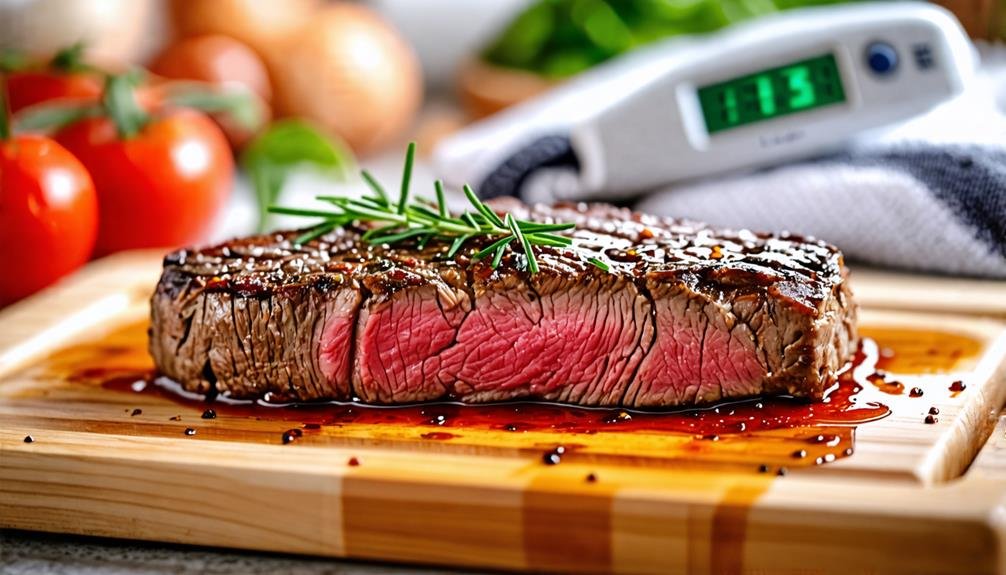Resting steak after cooking is important for achieving best tenderness and flavor. Generally, you should rest it for 5 to 10 minutes for thinner cuts, and up to 20 minutes for thicker ones. This allows the muscle fibers to relax and the juices to redistribute, enhancing juiciness and flavor. A good rule of thumb is to rest for 1 minute per 100 grams or 5 minutes for each inch of thickness. Remember to keep the steak warm and tent it loosely with foil to maintain its delicious crust. The art of resting transforms an ordinary meal into an extraordinary culinary experience!
Importance of Resting Steak
Why is resting a ribeye a crucial step in the cooking process? Resting a ribeye allows the muscle fibers to unwind and reabsorb juices, resulting in a more flavorful and tender final product. When you cook a ribeye, the intense heat causes these muscle fibers to contract, squeezing out precious moisture. If you slice into it too soon, all that succulent juice escapes, leaving you with a drier, less satisfying bite.
The benefits of resting are undeniable. By allowing the ribeye to rest after cooking, you give the juices time to redistribute throughout the meat, ensuring a uniform flavor and texture. Imagine biting into a ribeye that is not only bursting with flavor but also tender and juicy—this is what resting can achieve!
Moreover, resting a ribeye is a simple yet transformative practice in cooking. It elevates your dish from ordinary to extraordinary, allowing you to enjoy the freedom of culinary creativity without sacrificing quality. So, the next time you grill or pan-sear a ribeye, remember to take a moment to let it rest—your taste buds will thank you!
Recommended Resting Times
To achieve the best flavor and tenderness, it is essential to follow recommended resting times for beef after cooking. After grilling your beef to perfection, allowing it to rest is a crucial step that should not be ignored. A good guideline is to let your beef rest for at least 5 minutes, while culinary experts often recommend up to 10 minutes for optimal moisture retention. Larger cuts, such as roasts, may even benefit from a longer resting period of 10-20 minutes.
This resting period is important for redistributing the juices throughout the meat, enhancing both taste and tenderness. Imagine cutting into a beef steak only to see a stream of juices escaping; a disappointing sight that can be easily avoided! By following these beef preparation tips, you're ensuring your cooked meat is at its best.
Calculation Methods for Resting

Calculation methods for resting beef offer essential strategies to maximize moisture retention and elevate flavor after cooking. These approaches enhance your enjoyment of the beef experience. One commonly recommended technique is to rest the meat for 1 minute per 100 grams, which allows sufficient time for the juices to flow back into the beef. Alternatively, for those who prefer a more visual guideline, resting the steak for 5 minutes per inch of thickness ensures even the center of the cut has time to relax.
While there are various opinions on resting durations, these calculations provide useful starting points. It's important to note that larger cuts, such as prime rib or pork loin, may need extended resting times—sometimes up to 20 minutes—to achieve the best outcomes.
Ultimately, the objective is to appreciate the culinary craft by allowing your beef to rest, resulting in a more enjoyable meal. So, when you remove that steak from the grill or skillet, take a moment to savor the anticipation and allow those flavors to develop. After all, patience leads to delicious rewards!
Benefits of Letting Steak Rest
Allowing a ribeye to rest after grilling greatly enhances its tenderness and flavor by enabling the juices to redistribute throughout the meat. When ribeye is cooked, the muscle fibers contract, pushing their precious moisture out. However, by letting the steak rest, you allow those fibers to relax and reabsorb those juices, creating a succulent, juicy experience that delights the palate.
This simple act of resting transforms your dish from ordinary to extraordinary. Imagine cutting into that perfectly rested ribeye, and instead of a dry, disappointing bite, you are met with a burst of flavor and moisture. The juices, now evenly distributed, enrich every mouthful, making each bite a celebration of taste.
Moreover, the texture of the ribeye benefits significantly. Resting not only allows for better moisture retention but also contributes to a tenderness that can turn even the most robust cuts into a melt-in-your-mouth delight. So, when you finish cooking that beautiful ribeye, remember: patience pays off. Take a moment to let it rest, and relish the fruits of your labor. Your taste buds will thank you, and your guests will be singing the praises of your culinary skills!
Food Safety Considerations

Allowing beef to rest after cooking enhances flavor and texture while maintaining food safety. Resting your steak for 5 to 10 minutes boosts juiciness and adheres to safety guidelines. The Centers for Disease Control and Prevention (CDC) supports letting cooked meat sit before slicing, and resting steak aligns with this advice.
Food safety focuses on temperature and time management. While keeping cooked steak at room temperature for long periods is not advisable, a brief resting period of 10 minutes is typically safe. In fact, allowing your steak to rest for up to two hours is within safety limits, enabling slight cooling without risking health.
Common Mistakes to Avoid
In terms of resting steak after cooking, there are several common pitfalls that can compromise your culinary efforts. Cutting too soon, skipping the resting period altogether, or neglecting the thickness guidelines can lead to a less-than-satisfactory dining experience. By being mindful of these mistakes, you can guarantee that your steak is juicy, flavorful, and perfectly tender, elevating your meal to a whole new level of enjoyment.
Cutting Too Soon
Cutting a steak prematurely after cooking can severely impact its juiciness and taste. When you slice into a freshly cooked beef steak, the vital juices escape, resulting in a dry and less flavorful piece of meat. The muscle fibers contract during cooking, and cutting too soon causes them to release their moisture.
To truly enjoy a delicious steak, you must exercise patience. Allowing the meat to rest for at least 5 to 10 minutes allows the muscle fibers to relax, which helps the juices redistribute throughout the steak. Picture the moment when you finally cut into it, revealing a tender interior bursting with flavor!
Additionally, different cuts of steak, such as ribeye or filet mignon, may require varying resting times, so don't hesitate to experiment and discover what works best for you. By resisting the urge to dig in right away, you embrace the culinary art and elevate your dining experience. A well-rested steak is your gateway to a flavorful and texturally rich meal. So take a moment, enjoy the anticipation, and let that steak rest!
Skipping Resting Time
Slicing into a steak immediately after cooking is a prevalent error that can compromise the overall taste and texture of the beef. In the spirited quest for culinary excellence, many chefs cut into their steak prematurely, forfeiting that juicy, tender experience we desire. When the resting period is omitted, the muscle fibers—having tightened during cooking—cannot relax and absorb the savory juices. Consequently, your expertly cooked dish transforms into a disappointing, dry morsel.
Envision the delightful burst of flavors that awaits after a short pause! Allowing the steak to rest for merely 5 to 10 minutes permits those juices to redistribute throughout the beef, guaranteeing each bite is moist and flavorful. This straightforward step is your gateway to a more gratifying dining experience, enhancing your steak from commonplace to remarkable.
Ignoring Thickness Guidelines
Many home chefs underestimate the significance of resting time in relation to steak thickness, which can significantly impact the juiciness and flavor of the meat. The thickness of a beef steak directly affects its cooking time and resting duration. A thin cut, like a flank steak, benefits from a brief resting period of about 5 minutes. In contrast, a thicker piece, such as a two-inch Porterhouse, warrants a more extended resting time—consider 10 minutes or longer.
Disregarding these practices can lead to an unsatisfactory meal experience. Slicing into a steak prematurely may cause a flood of flavorful juices to escape, resulting in dry, tasteless meat. Imagine the rich juices that could have been absorbed during those valuable resting moments instead!









